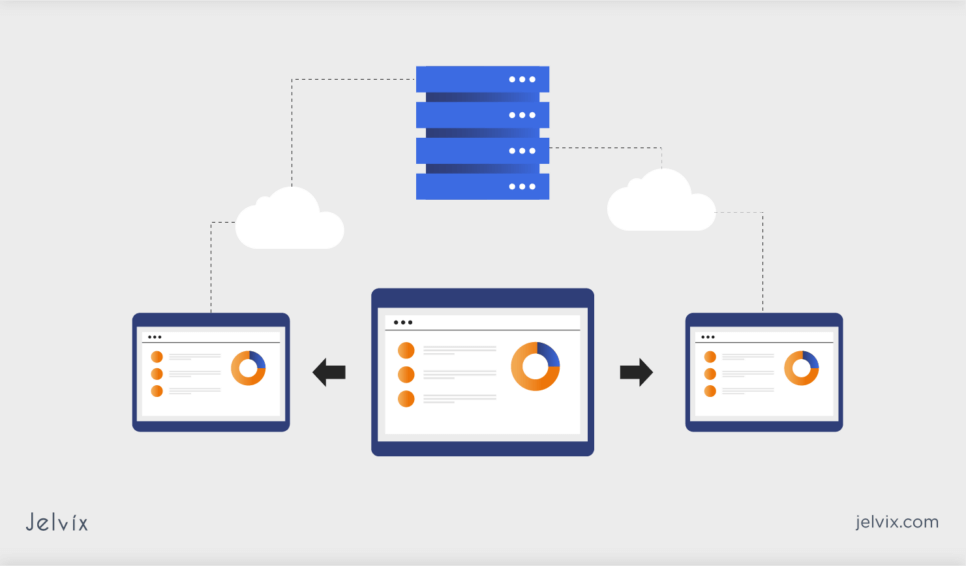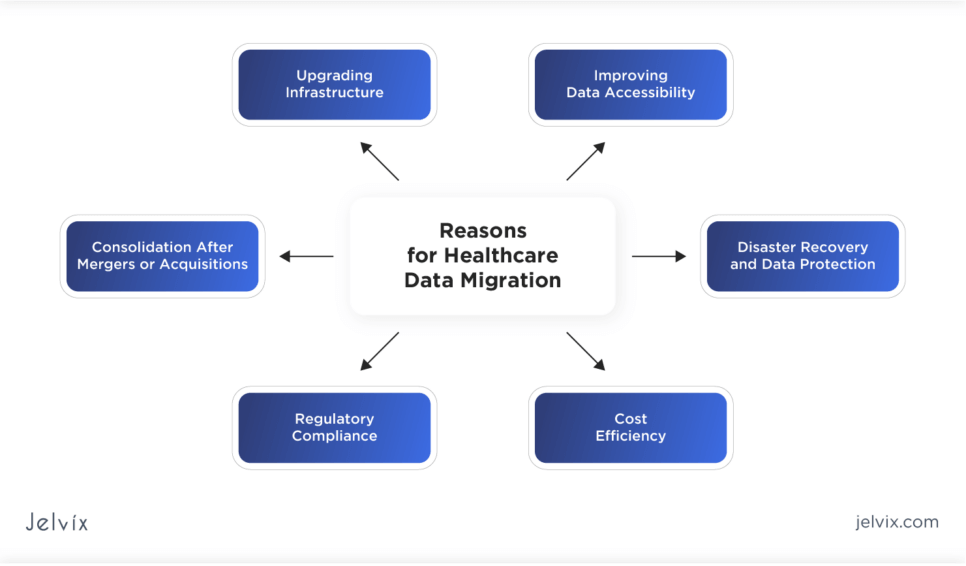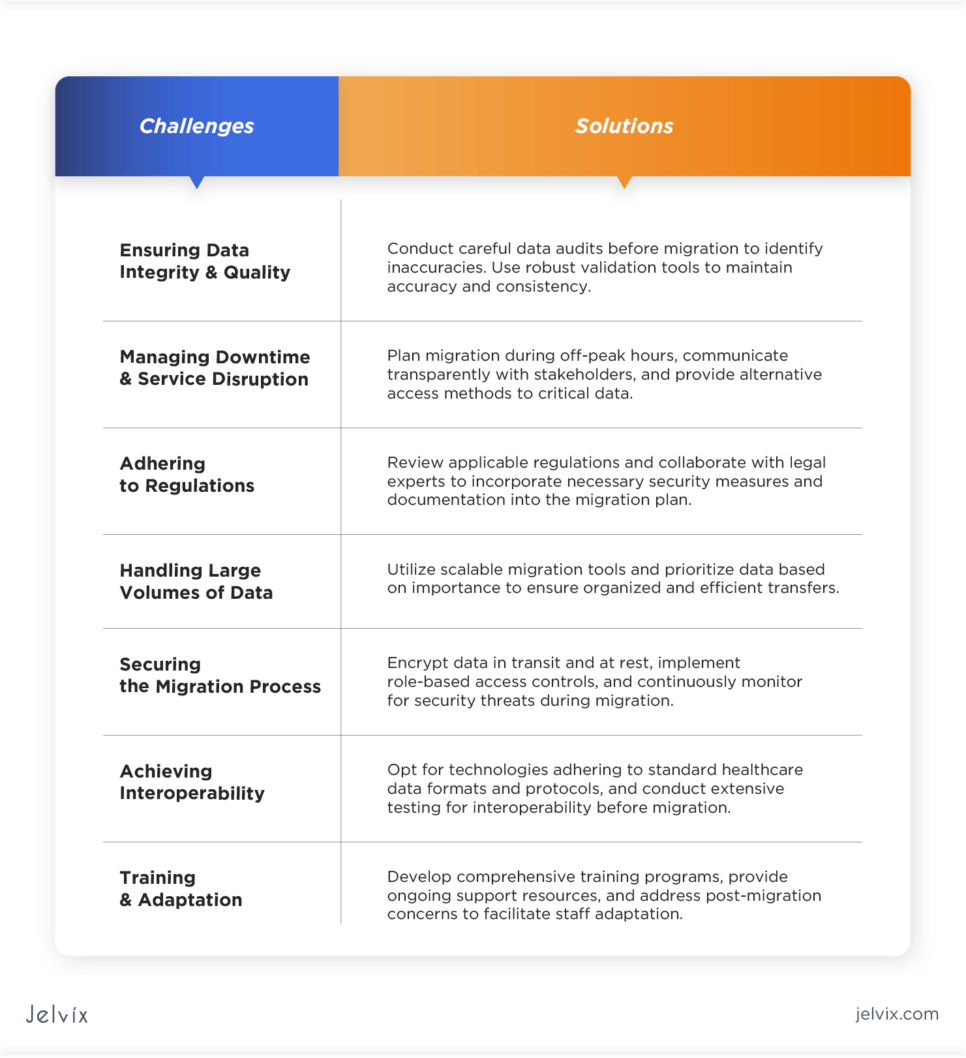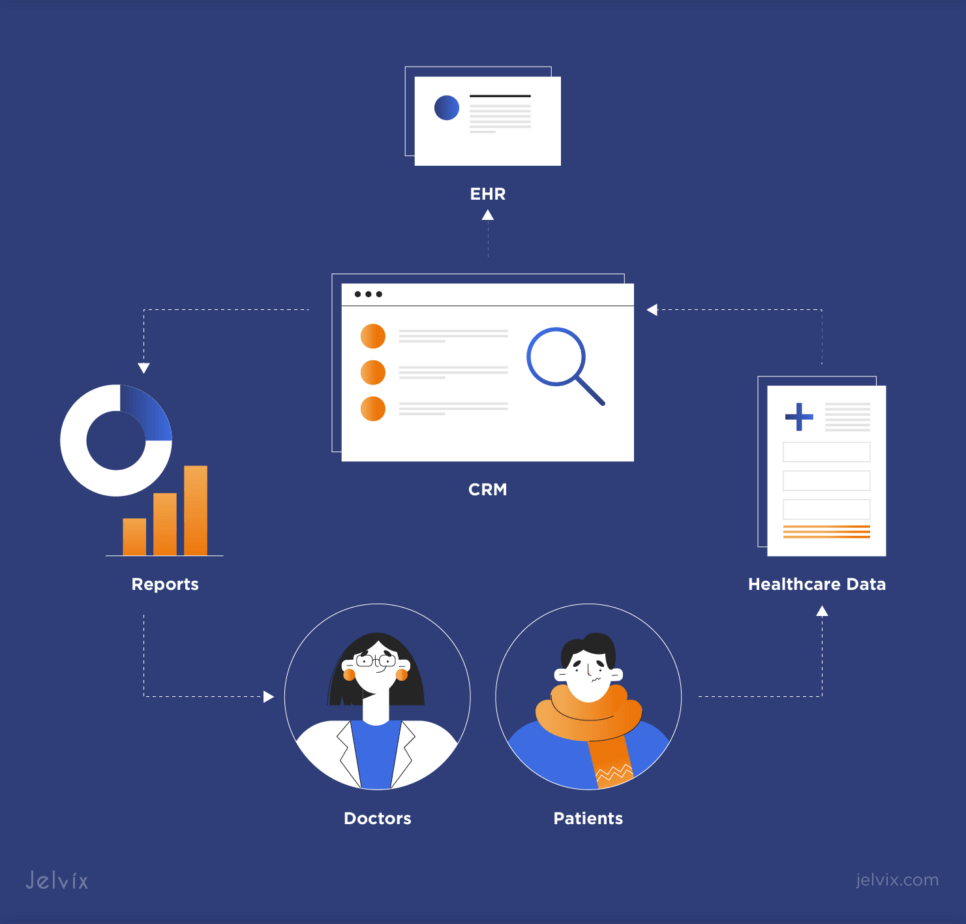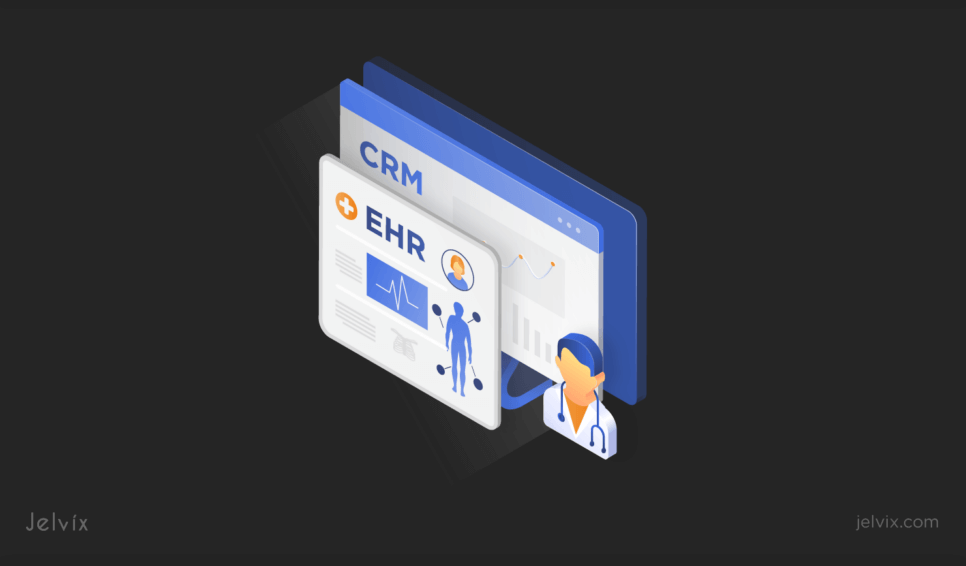About 30% of the world’s data is generated by the healthcare sector, according to RBC Capital Markets research. What’s more, its growth is expected to explode at a 36% annual rate already in 2025.
With the data amount climbing higher, healthcare companies need to think about transferring it to safer storage harbors that comply with current industry regulations and are interoperable with existing medical systems.
If you recognize the need for your medical data to be migrated and want the process to be error-free, read this article. You’ll find out more about common data migration challenges in healthcare, explore possible solutions, and learn how to choose data migration tools that suit your company’s needs.
Reasons for Healthcare Data Migration
Healthcare companies may need to migrate patient data for a variety of reasons. Key motivators behind this decision range from planned system upgrades to the need to adhere to new industry regulations.
Upgrading Infrastructure
Healthcare organizations often migrate data to upgrade to more advanced medical systems that offer better performance and security and provide a broader set of features. This can include moving to newer versions of existing systems or completely different platforms that better meet current medical organization’s needs.
Consolidation After Mergers or Acquisitions
When healthcare companies merge or go through acquisition by larger corporations, they need to consolidate data into a unified system for seamless operation. This involves migrating data from multiple systems into a single integrated platform to ensure continuity of care and efficiency.
Regulatory Compliance
Changes in healthcare regulations may require data migration to systems that ensure better compliance with new legal requirements. This can include migrations to systems that offer enhanced data protection, privacy controls, and audit trails.
Improving Data Accessibility
Migrating to systems that facilitate access to patient data and support interoperability among different healthcare systems is a key goal for many organizations. This ensures that patient data can be shared more efficiently across care teams, improving the quality of care and patient outcomes.
Cost Efficiency
Migrating to more cost-effective systems can help healthcare organizations reduce operational costs. This includes moving from on-premises data storage solutions to cloud-based services, which can offer significant savings on infrastructure and maintenance expenses.
Disaster Recovery and Data Protection
Implementing robust disaster recovery and data protection measures may require data migration to systems with better backup and security features. This helps protect sensitive healthcare data against cyber threats and ensures the company keeps operating in case of data loss.
Note that you don’t necessarily need to use all the tools listed above. Select the appropriate instruments depending on the data complexity, the source and destination environments, and specific regulatory compliance needs.
Medical Data Migration Process Overview
The primary goals of medical data migration are usually to improve the accessibility, security, and usability of the data, enhance healthcare delivery, and ensure compliance with healthcare standards. Conducting this process successfully requires planning, the right tools, and a focus on maintaining data integrity to fully realize the potential benefits.
Discover how FHIR standards facilitate healthcare interoperability, ensuring seamless data migration and exchange across systems.
Healthcare Data Migration Implementation: Key Stages
Medical data migration is a complex process that requires careful planning, execution, and validation to ensure data integrity and minimal disruptions to healthcare operations. It involves several stages, designed to ensure that the transfer of sensitive information is carried out securely and accurately.
Preparation and Planning
Planning involves defining the scope of the migration project, setting objectives, and identifying specific datasets to be migrated. It includes selecting appropriate tools and technologies for the migration, assigning roles and responsibilities to the project team, and developing a detailed project timeline.
Data Assessment
Before you start the migration, it’s necessary to assess the existing data. This stage involves examining the quality, format, and structure of the data you need to migrate. Make sure to identify any issues, such as data duplication, inconsistencies, or gaps early on, for a painless migration process.
Designing the Migration Strategy
Based on the insights gained from the data assessment phase, you can design the migration strategy. This includes mapping out how data will be extracted from the source system, transformed to fit the requirements of the destination system, and finally loaded into the new environment. At this stage, you also need to build the scripts or use pre-existing migration tools to automate as much of this process as possible.
Testing
Before fully committing to the migration, make sure to conduct testing. This includes performing test migrations with a subset of the data to ensure the process works as expected. Testing helps identify potential issues before they can affect the entire dataset or disrupt operations.
Execution
With planning, design, and testing complete, you can head to the execution phase. It involves carrying out the actual data migration according to the developed strategy. This phase needs to be carefully managed and monitored to promptly address any arising issues.
Validation and Review
After all the data is migrated, it’s time to validate the process. You need to ensure all data is transferred accurately and the new system is fully operational. This includes verifying data integrity, ensuring that all functionalities work as expected, and confirming compliance with any relevant regulations.
Support and Optimization
When the migration is complete, you need to conduct ongoing support and maintenance to address any post-migration issues, ensure the new system is up-to-date, and make any required adjustments based on user feedback or changes in data requirements.
Types of Healthcare Data Migration Tools
Successful patient data migration requires the right set of tools to ensure data is moved accurately and securely from one system to another. These tools facilitate the transfer process and help maintain the integrity and usability of the data after the migration.
Extract, Transform, Load Tools
ETL tools extract data from the source system, transform it to match the format of the destination system, and then load it into the new environment. Tools, such as Jaspersoft ETL and Talend, are known for their ability to handle large volumes of data and complex transformations, making them ideal for migrations involving disparate systems.
Data Replication Tools
Data replication tools, such as Oracle GoldenGate and IBM InfoSphere Data Replicator, are used for creating copies of data in real time from the source to the destination system. These tools ensure that data remains synchronized between the old and the new systems during the migration process, minimizing downtime and data inconsistency.
Data Quality Tools
Data quality tools help in cleaning, validating, and standardizing data before and after the migration. Tools like SAS Data Management identify and rectify issues such as duplicates, missing values, and inconsistencies, and ensure high-quality data in the new system.
Database Migration Tools
Specifically designed for migrating databases, these tools support the transfer of data across different database platforms. They help move data from legacy databases to modern systems, handling data type conversions to ensure compatibility. Wide-spread database migration tools include Microsoft SQL Server Migration Assistant and AWS Database Migration Service.
Cloud Migration Tools
Cloud migration tools like AWS Snowball and Google Cloud’s Data Transfer Appliance facilitate the secure transfer of healthcare data to cloud environments, offering features for data encryption, transfer optimization, and integration with cloud storage.
Custom Scripts and APIs
In some cases, off-the-shelf migration tools may not meet the specific needs of a healthcare data migration project. In this case, consider improving these tools or developing custom healthcare solutions, including scripts and application programming interfaces, to tailor the migration process. Custom tools will provide flexibility and precision for unique data structures and requirements.
The Smart Way to Choose – Download Your Guide to Selecting the Right Healthcare Tech Partner!

Common Challenges in Data Migration and Practical Solutions
According to the report, 83% of data migration efforts fail or exceed the set budget and timelines. It means that underestimating the complexity of this process can cost you millions of dollars and hundreds of working hours for your team. Medical data migration is full of challenges, given the sensitivity, volume, and complexity of the data involved, so addressing common data migration issues is key to a successful data transfer.
Ensuring Data Integrity and Quality
Data integrity and quality are critically important in healthcare, as inaccuracies or loss of patient info can lead to fatal mistakes in care. The migration process risks compromising data integrity and quality if not carefully managed. As a result, patient data might become corrupted, incomplete, or inconsistent when transferred across systems.
To prevent such outcomes, conduct a careful audit of the data before initiating the migration. Make sure to identify inaccuracies and inconsistencies, allowing for corrections and ensuring only high-quality data is migrated. Employ robust data validation tools to maintain data integrity, making sure that each piece of information remains accurate and consistent from source to destination.
Managing Downtime and Service Disruption
Healthcare services heavily rely on the availability of data. Migrating data, especially in large volumes, can lead to significant downtime, disrupting patient care and clinical workflows. Plan the migration during off-peak hours and in separate stages to minimize the impact on essential services. Transparent communication with all stakeholders regarding the migration schedule and alternative access methods to critical data during downtime can help maintain operational continuity.
Adhering to Regulations
The healthcare industry is strictly regulated with set requirements for handling and storing patient data. Migrations must comply with laws like HIPAA in the U.S. and GDPR in Europe, as well as take into account any local regulations. This poses a challenge in ensuring all data adheres to these standards during the migration.
A comprehensive review of all applicable regulations before the migration process can be a good idea. Collaborate with legal and compliance experts to map out a migration plan that includes necessary security measures, consent protocols, and documentation.
Handling Large Volumes of Data
The large volume of data in healthcare systems, including patient records, imaging data, and historical health information, makes migration a complex task. The risk of data loss or corruption increases with the bigger amount of transferred data.
Use scalable migration tools designed for high-volume data transfers to manage and monitor the process, ensuring data integrity. Prioritizing data based on its importance and usage allows for a more organized migration, ensuring high-priority data is transferred with precise attention.
Securing the Migration Process
Protecting sensitive healthcare data against breaches and unauthorized access during migration is critical. The process exposes data to potential vulnerabilities, especially when transferring over networks or to cloud-based systems.
Encrypt data both in transit and at rest throughout the migration process. Implement role-based access controls and continuously monitor the migration for security threats to protect medical data.
Achieving Interoperability
Ensuring the new system can seamlessly communicate with existing healthcare systems and databases is vital for a healthy medical ecosystem. Lack of interoperability in healthcare can lead to siloed data, affecting patient care and operational efficiency.
Opt for technologies and platforms that adhere to standard healthcare data formats and protocols, so that the new system can easily integrate with others. Conduct extensive testing of interoperability capabilities before fully committing to the migration. This will help identify potential issues early, allowing you to make adjustments and ensure smooth system integration.
Training and Adaptation
Migrating to a new system often involves changes in workflows and processes. Ensuring that all healthcare staff is adequately trained and comfortable with the new system is needed to maintain the quality of care.
Develop comprehensive training programs for your staff, taking into account their technical proficiency. Ongoing support and resources, including help desks and online tutorials, can address post-migration concerns and facilitate a smooth adoption for all users.
Strategies To Choose the Right Data Migration Tools
Selecting relevant data migration tools can significantly impact the efficiency, security, and compliance of the migration process. By following the best practices offered by the Jelvix team, you can ensure a smooth transition that safeguards data integrity and complies with healthcare regulations.
Assess Data Complexity
Start with estimating the complexity and volume of your healthcare data. Choose a tool that can handle specific types of data you’re migrating, including EHRs, screening data, and lab results.
Ensure Regulatory Compliance
The chosen tool must comply with healthcare regulations like HIPAA and GDPR. Look for features that support data encryption, audit trails, and secure data transfer to maintain patient privacy and data security.
Evaluate Integration Capabilities
Your tool should seamlessly integrate with the source and destination systems. The tool must support standard healthcare data formats like FHIR and HL7 to ensure interoperability and minimize disruptions to healthcare workflows.
Consider Scalability
The tool should be scalable to future data growth and additional migration needs. Scalability ensures that your investment remains relevant as your organization’s data management requirements change.
Ensure Support and Maintenance
Make sure the tool provider offers ongoing maintenance, especially for complex migrations. Look for developers that offer comprehensive support services, including troubleshooting, updates, and maintenance.
Check for Data Quality Features
The ability to clean, validate, and deduplicate data during the migration process is essential. A tool with built-in data quality features can help ensure that the migrated data is accurate, complete, and usable.
Look for User Reviews
Investigate user reviews and case studies from data migration projects similar to yours. Insights from other organizations’ experiences can provide valuable information on the tool’s performance and reliability.
Healthcare Data Migration Solutions by Jelvix
As an experienced technical partner, the Jelvix team offers comprehensive solutions for seamless data migration in healthcare. By creating a strategy for data migration, carefully managing data transfer to the cloud with the help of advanced technologies, and providing software interoperability, Jelvix ensures a smooth transition of sensitive patient data with minimal disruption to medical operations.
Creating a Data Migration Strategy
The Jelvix development team can help in creating a tailored data migration strategy that aligns with the specific needs of your medical entity. This involves assessing the scope of data to be migrated, planning the migration process, identifying potential challenges, and establishing clear objectives to ensure a successful migration.
Transferring Patient Data to the Cloud or Another EHR/CRM
Our team of experts possesses many years of experience in CRM-EHR integration and secure transfer of patient data between these systems or to cloud-based platforms. The Jelvix team ensures that all data migration activities comply with healthcare regulations like HIPAA and GDPR, prioritizing data integrity and security throughout the process.
FHIR Implementation To Achieve Software Interoperability
To achieve seamless interoperability between disparate healthcare systems, we use established medical data standards, including Fast Healthcare Interoperability Resources. Our FHIR-based custom solutions facilitate data mapping, support modular integration, and ensure a user-friendly experience within an existing healthcare ecosystem.
By using custom medical solutions by Jelvix, healthcare organizations get expert guidance and advanced technologies for their data migration projects. Our approach ensures that your data migration is strategic, secure, and interoperable.
In case you’d like to develop a solution that will facilitate your medical data migration, you’re welcome to contact our experts for tailored advice based on your company’s needs.
Start Your Data Migration
Ensure your healthcare data migration is seamless and error-free with a reliable technical partner.


